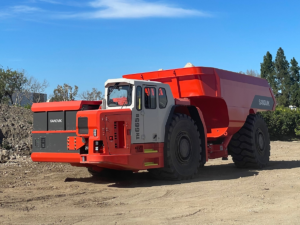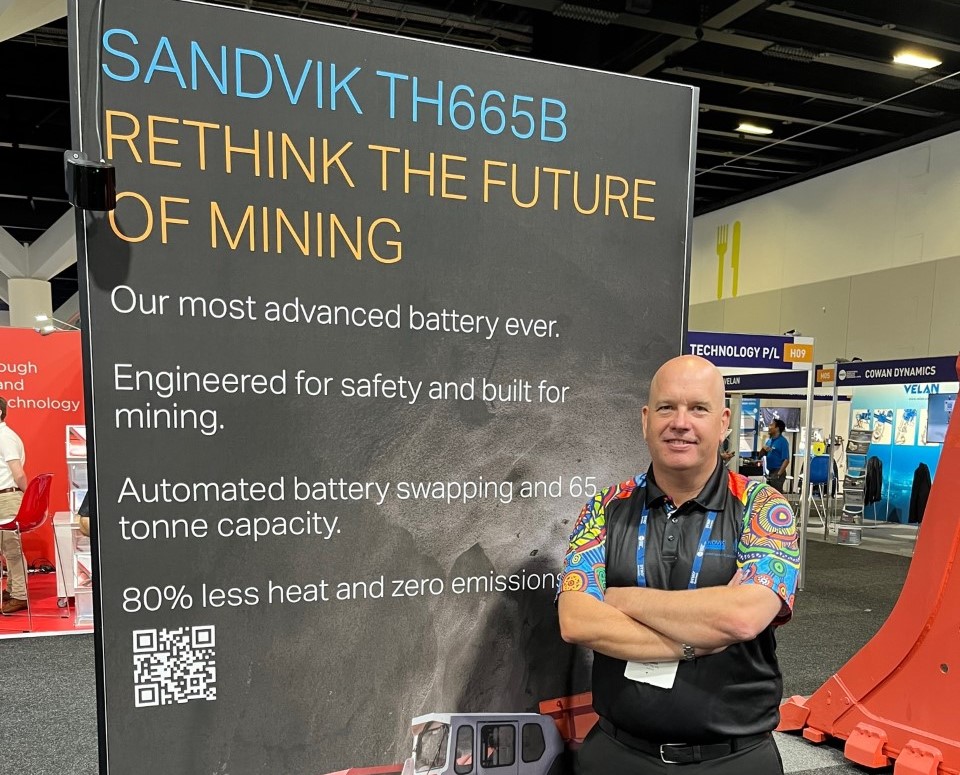While the first wave of battery electric mining equipment has come in North America and Europe, Australia arguably represents the next big focus. Sandvik Mining & Rock Solutions’ new 65 t TH665B arrived in the country in Q4 2022, and will go into field testing in 2023. At the IMARC 2022 event in November, IM Editorial Director Paul Moore had the chance to sit down with Daniel Yearn, Business Development Manager – Battery Electric Vehicles, Load & Haul at Sandvik (pictured) who is Perth-based, to talk about the journey so far and the potential for BEVs in that part of the world.
Sandvik acquired Artisan Vehicle Systems back in 2019, who already had a lot of experience with battery electric mining vehicles, particularly in Canada, and of course were the developer of the Artisan battery system so in a way it was natural for that part of the world to be the initial focus – such as the Kirkland Lake Gold (now part of Agnico Eagle) operated Macassa gold mine and Newmont’s Borden gold mine, both in Ontario. Sandvik at the same time began going through the process of industrialising the former Artisan machines – ensuring commonality with the rest of the Sandvik machines on things like cabs, control systems and structural elements while retaining the advantages of the Artisan battery technology. This began with the A18 becoming the LH518B followed by the replacement of the Z50 truck with the TH550B.
Trials in Australia include with the Sandvik LH518B at Fosterville and St Ives

Looking at current trials of these machines in Australia – Yearn said there are two currently – with Gold Fields at St Ives in WA, where a Z50 truck and a LH518B are being trialled; and at Agnico Eagle’s Fosterville operation in Victoria, where they are also trialling a LH518B which began work in late October 2022. Beyond these is the all new TH665B, which was developed from the ground up, first launched at the Electric Mine 2022 conference in Stockholm – Yearn said this was going in Q1 2023 for site acceptance testing with contractor Barminco at AngloGold Ashanti’s Sunrise Dam operation in WA, with the machine trials coming under a tripartite agreement between Sandvik, Barminco and AGA.
On the TH665B, Jakob Rutqvist, Global Sales Director for battery-electric trucks and loaders within Sandvik has stated: “A majority of the world’s miners have adopted net zero emissions targets. In a typical underground mine, 50-60% of CO2 emissions come from the mobile fleet, hence low- and zero-emissions technology is critical for meeting the industry’s targets. The large 60+ ton trucks are favourite machines of many Tier 1 miners and mining contractors today. With the 65 ton TH665B, Sandvik introduces a step-change large scale, productive and sustainable mining.”
Yearn added: “Barminco is a fantastic supporter of Sandvik equipment and we have done a lot of work with them over the years on loader and drill development. These are the types of customers who know our equipment inside out so it is great to have collaborative partners like Barminco to work with and ensuring we are delivering the machines that our customers are looking for.”
Contractors of course have a different business model to an owner operator, so it has to work for them taking all of the cost inputs into account they are exposed to. And on that basis, as well as for owner-operators – battery operation combined with autonomy has the greatest potential given that it will allow the vehicles to take advantage of higher speed capabilities – uphill BEV trucks can travel 25% faster than diesel trucks but those high speeds today are most likely to be achieved with automation due to the added safety factor. Sandvik plans to launch the first commercially available BEV in mining equipped with full automation capability in the first half of 2023.
The Sandvik TH665B will soon begin work with contractor Barminco at AngloGold Ashanti’s Sunrise Dam

Australia is ready for BEV take-up
From Sandvik BEV roadshows in Australia, which have included the Z50, and conversations with prospective customers, what has the feedback been like on the underground electric transition? What level of appetite is there to roll out electric fleets on a widespread basis beyond trials and tests? Yes, the miners have all made long term net zero commitments but there is no mandate per se to get fleets electrified by a certain date.
Yearn commented: “I would say the Australian miners have three main drivers – towards zero diesel particulates in the underground working environment is a big one for operator health; along with having zero carbon emissions as part of that roadmap to net zero; secondly it is about ventilation and heat. BEVs produce about 85% less heat than diesel vehicles – this combined with no DPMs brings a major opportunity to cut ventilation infrastructure and costs underground significantly. And finally it is also about the wider ESG push to be more sustainable.”
It is also worth noting again that Sandvik (and the other two big underground primary fleet OEMs) released their first BEVs in North America and/or Europe first with Australia representing a second wave. “So we need to get as many hours of BEV operation as we can under our belt in Australian conditions – once we have an extensive data set and analytics showing that these machines are working well operationally and delivering their stated benefits, with increased productivity and battery swapping performing as expected, then I think we will see them go from strength to strength in this market.”
Australia, just like the rest of the world, remains at the early adopter phase, with customers looking to make a first step on their net zero pathway. He also said that they obviously want to be able to match or exceed the productivity of current machines. As stated, they are faster, particularly on up-ramps, and while the battery swapping is an extra time factor, with Sandvik’s AutoSwap, it is a relatively quick process. Yearn says the main challenge is actually to get the planning right, as it’s not like diesel where you fill it up and it can operate anyway. Plus for now, battery swapping is not possible with the machine in autonomous mode.
So planning for electric is definitely the big focus currently in Australia. “We are doing a lot of application study work to understand where the machine is going to be operating so we can identify where those AutoSwap bays need to be and the optimal time to swap the batteries for that particular project and its load and haul cycles. How long the batteries will last in a shift really depends on how those machines are working. For the loaders as an example we expect a typical working time of 3 to 4 hours meaning in general you are looking at doing a swap halfway through a shift then one at the end of the shift. Also because the battery technology is so new, customers want to have a detailed understanding of the different safety related scenarios and what procedures they need to put in place to react to any potential issues. Battery logistics are also a consideration, in getting batteries moved underground in the first place and if any maintenance on them is required. This is particularly the case for deep shaft mines versus those with service access via a decline.”
On regulatory issues, Yearn said that there is nothing restrictive related to the batteries themselves given that the lithium iron phosphate chemistry that Sandvik uses is one of the safest options. As an example, the lithium iron phosphate energy release in a fire is only about 100th that of an NMC battery and any issues are almost always contained in the battery pack without propagation. He did say there were some electrical infrastructure regulations that need to be complied with that are being worked through on a state by state basis but are just routine. The emergency response issue, as already stated is being worked through directly with mine operators – particularly how they should respond to a battery related fire and the right protective equipment that would need to be used.
Lastly, how do we go from mines using two or three machines to them rolling out full BEV fleets? “One of the biggest determinants of that is how a mine’s power is generated. That will be a big factor as for green mines with green power, a full BEV fleet will make perfect sense right from the start. A lot of the mines in Australia are in the process of implementing or planning for green power, so that will likely dictate those operations that go all in first.”











